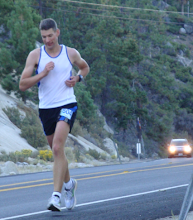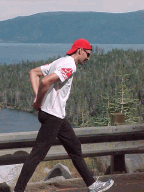Check Out the Animoto Slideshow!
We just came back from another Tahoe Triple Marathon weekend. Here's the recap:
Pre-Race
Training and organization for the Super Triple started long before the actual race. I took a little break from running after a great series of spring races and kicked off my training again in July. My goals were to (a) run sub-19, (b) run sub-20, or (c) just finish the race. Goals a an b would probably be enough for a fourth straight win. A good run at the Lake of the Sky trail marathon two weeks before the race proved (to me) that I was ready. I put in the training for this target race. Unfortunately, for reasons beyond my control, these goals will have to wait for next year to be realized.
Chris, Rebecca, and I headed down to the Horizon Casino for the annual pre-race briefing. There were lots of familiar faces to catch up with: RD Les Wright, Triple coordinators Angel and Lucia, fellow 3-time Super Triple finisher Keenan Follis, and many other runners that I had run with in previous years.
Sean Meissner and Thomas Reiss gave the now oh-so-familiar--but still very entertaining--pre-race speech about running the three consecutive marathons and most of the first-time triplers were soaking up the information. Speaker Bart Yasso told us some funny anecdotes from his long running career, and after the pre-race dinner, I met Russell Secker, who had recently run across Europe (check out his new book titled "Running through Countries").
Day 1
It was a pretty hot day (with temperatures near record highs), so I held back a little bit in the second half of the marathon, walking some of the uphills. I ran 3:30--a little slower than I had hoped for, but OK given the warmer weather. I was first in the Super Triple with Lambert Timmermans 15 minutes behind me.
I decided to buy some ice and soak my legs in the bathtub instead of standing in the lukewarm lake (less time in the sun). The rest of the day we spent relaxing. Vicky and the kids joined us in the evening and she brought some killer home-made lasagna for dinner.
Just before dinner, I decided to quickly check my mail and, just like that, my race was over.
As it turned out, the Lake Tahoe Marathon (LTM) organization had applied for a permit too late and Cal Trans and NDOT, being the running fans they are, had denied the permit to run the race. For LTM to continue to host the race would be a pretty bad violation, so everyone was offered a refund or a "downgrade" to the marathon. Super Triple runners could simply run the kids' run, er I mean the the Triple, instead, since they had already finished Day 1. The only alternative was that runners could run an unofficial "72-mile jog" around the lake by themselves.
Some other runners suggested I run the unofficial run, but honestly, that did not make sense to me. If I wanted to just run around the lake at night for fun, I could do that any time. I felt a bit confused; mad and sad at the same time. Mostly, I was wondering what I should do now. Should I go after a certain place in the Triple or just have fun?
The regular Triple, felt like a 5K in terms of raw speed. When I trained for my sub-3 marathon in April, I had done a lot more speed work. Now the focus for the Super Triple had been much more on long runs and perfecting long distance power-walking. I can now easily power-walk 12-minute miles for hours on end and I think that is one of the keys to Super Triple success. You know you're not going to be able to run the entire distance, so the key is to cover lots of ground while you're walking.
Day 2
I decided to at least finish the regular triple (this way, I'll have three regular and three super triple finishes), but--for once--have some fun with it, too. Why not back off the pace just a little bit, and enjoy the scenery, the mountain air, listen to some music?
At the start of the second marathon, I did just that. The first 10 miles is mostly downhill from Spooner Summit to Incline Village. I cranked up some music on the iPod and flew down the hill. Suddenly, an rare runner's high kicked in that lasted pretty much throughout the entire run.
With about ten miles to go, a couple of runners passed me. One of them was running just the Saturday marathon (The LTM offers a-la-carte marathons on Friday and Saturday). With three miles to go, Vicky and the kids drove by and Rocky yelled out of the window that it was time to "catch some bogies." Sure enough one of the runners came back into sight. First 300 yards out, then 200. Maybe I could still pick up one more place.
We entered the downtown area of Tahoe City. Maybe too much distance to cover, maybe not. I sped up some more and kept inching closer and closer. With about 100 yards to go I surged past the other runner and blasted to the finish with Rocky and Sean running next to me on the sidewalk. I finished in 9th or 10th place overall and would have been first again in the Super Triple. I heard LT pulled out with some knee issues in Incline Village--I hope that heals up before you next 100-miler in two weeks, LT!
We had planned out a good routine for after the second marathon. In the Super Triple, you only have about 10 hours until the start of the 72-miler, so it is important to be efficient. Now that I would have a full night of rest, we could afford to take it easy. I stuck around and chatted with some of the other runners and I spent the rest of the day relaxing and icing the legs in the bathtub again.
Day 3
The final marathon of the Triple is run with the regular (single) marathon and thus with a much larger crowd. Before the race started I caught up with Oswaldo Lopez, who looked like he was in great shape to go after a fast time in the 72-miler. Maybe he could even get close to Rae Clark's 9:06. His attempt will also have to wait another year, due to the 72-mile ultra run cancellation. Oswaldo was going to run the marathon instead.
Before the start, I met Gretchen and Turi. I had run with both of them only two weeks earlier in the Lake of the Sky trail marathon. Sean Meissner looked ready to go, but he would definitely have some tough competition. For example, Lynryd Skynrod, who was first in the Triple had been cranking out some very fast times (2:43 and 2:54 on days 1 and 2) and Ian, and English runner, had been pretty close behind him.
I paced a few miles with Gretchen, who had been out with a cold all week. She was not sure if she was going to run until the day before the race. Well, it was a good thing she did, because she went on to win the marathon--Go Gretchen! (Oh, and I am now adjusting your target time for the Helen Klein 50-miler to sub-7:00, Gretchen!)
I had fun chatting with some of the marathon runners, including a runner from Costa Rica, who was running his first marathon. I am pretty sure he made it sub-4. I also ran with Dr. Jeff Shapiro, talking about the negative effects of pain killers and too much food during a race. Jeff is a co-organizer for the 200-mile Relay in Napa, which might be a fun race to put on next year's schedule.
Having fun and running three marathons on three days are not often found in one sentence, but I was enjoying the beautiful weather and the fantastic scenery. It was nice to run with one of the lanes of the highway closed for a change, too.
That said, It was bit hard to get a good running rhythm going on the flat parts of the course, but as soon as I entered the hills, things felt better. I would power-walk the uphills and run all the downhills hard, making up for the slower pace on the flats. Sure, the legs were feeling it after so many road miles, but overall I felt OK; the end was in sight.
 Power-walking the Uphills
Power-walking the UphillsTroy crewed for me on day 3 and kept me fed and watered throughout the race. It was another hot day and it was nice to have some extra water and Gatorade between aid stations. The volunteers on the course and at the aid stations were also doing an awesome job keeping everybody hydrated.
Once you reach mile 72 in the Triple, at Inspiration Point, you have run around the entire lake. The final 6 miles after that are mostly downhill. First steep downhill and then more gradual and flat.
I could still make it under 4 hours if I kept going steadily and I made it with a minute and a half to spare. I saw Turi at the finish, who had finished just a few minutes ahead of me. Gretchen had won the female title and, as expected, Sean Meissner had come in first in the marathon. A great win on a hot day.
Florida's Leslie Stallings won her first Triple, even though this was her first ultra and her only goal was to finish. She pushed hard and it paid off. Lynryd Skynrod won his second Triple and smoked a celebratory cigarette almost immediately after crossing the finish line. Rumor has it that he is considering the much gentler and more lucrative sport of cage-fighting instead of running another Tahoe Triple.
We hung out at the finish on Pope Beach for a while, catching up on race stories and picking up the awards. IRunFar's Bryon Powell was there as well, getting ready to pace Kilian Jornet's TRT-165 speed record attempt. I would have loved to come out to pace or crew for that as well, except, doing that the day after the Triple would probably not be the best idea.
Finally, a huge thank you to Vicky, Sean, Rocky, Chris and Rebecca, Troy and Zimfira, and Rory for helping me even though the event we planned for never happened. You rock and I simply could not have done it without you. Thanks!






















































